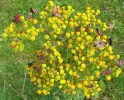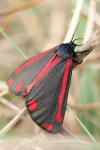PILGRIMSPLAZA
Active Member
Pilgrimage is of all people, faiths, sferes and ages - for hunters, gatherers and smorgasbordians:
The Jacob Sheep got its name from the bibel story about Jacob who was payed for his work in Labans herd with all the spotted sheep. * At work in Denmark making a 850 Km cycle route when dusk was already falling I suddenly said to my collegue that I saw a sheep with four horns. He said: 'Yess; you're right: it's getting late and we should stop. But we drove back and there she was in all her glory with two standing horns and two drooping and hanging rather loosely ones. Much later I saw a small herd in a recreational area in our province.
The Jacob Apple is also called Yellow Transparent or even Blanke (Blanche) Madeleine; now isn't that a beautiful coïncidence? It's an old race from Russia and it was grown in the 19th century in France. They are on sale again.
http://www.jacobsheep.freeserve.co.uk ; http://www.jacobschaap-rackaschaap.nl : The Jacobsheep was named after the biblical story of Jacob who earned the spotted sheep in Laban's herd. * Het Jacobschaap ontleent zijn naam aan het bijbelse verhaal over Jacob, die als loon voor zijn werken alle gevlekte schapen uit Labans kudde mocht afzonderen en behouden.
http://www.jabikspaad.nl/nl/actueel/schaap.html : http://photo.zootrotters.nl/thumbnails. ... up&cat=-15 : Jacobsschaap - Vierhoornschaap ( Ovis aries aries jacobs_four_horned ) Jacob's four-horned sheep
http://www.jabikspaad.nl/nl/actueel/appel.html ; http://www.skries.nl/Jabikspaad/Wandelt ... tappe1.htm ; http://www.adopteereenappelboom.nl/nieu ... uliV1.html : De meeste appels zijn pas in september rijp, maar Yellow is er altijd heel vroeg bij: hij wordt al in juli geoogst. Onze teler William Pouw in Schalkwijk teelt deze appels. Het is een enigszins doorschijnende bleekgroene of lichtgele appel met wit, sappig vruchtvlees. Hij is een oud ras, waarschijnlijk afkomstig uit Rusland, en werd in de 19e eeuw al in Frankrijk geteeld. Hij wordt ook wel St. Jacobsappel of Blanke Madeleine genoemd.
http://library.wur.nl/speccol/fruithof/ ... kst024.htm : many more beautiful names and countries mentioned!
http://nl.wikipedia.org/wiki/Sint-jacobsvlinder : nice picture of a Sint-jacob's butterfly; I saw them in Portugal near the giant statue of Christ at Lisboa bridge. This Cinnabar moth (Tyria jacobaeae) and its worms live on the very, very poisonous ragwort (Senecio or Dutch Jacobskruiskruid). Cinnabar after vermilion, the colour of common ore of mercury. In Latin it was known as minium, meaning also "red lead" - a word probably borrowed from Iberian (cf. Basque armineá "cinnabar").
http://en.wikipedia.org/wiki/Cinnabar ; http://en.wikipedia.org/wiki/Cinnabar_moth ; http://en.wikipedia.org/wiki/Senecio_jacobaea ; http://commons.wikimedia.org/wiki/Tyria_jacobaeae
Later I found: http://seeds.eldoc.ub.rug.nl/root/Asteraceae/Jacobaea ; http://plants.usda.gov/java/profile?symbol=SEJA : stinking willy ; http://www.plantenvinder.net/plantenzoe ... /44850.htm : Polemonium jacobaea ´Richardsonii´
http://www.ideboda.nl/herbarium/composi ... kruid.html : Jacobaea vulgaris ssp. dunensis wonderful picture full of beautiful butterflies: These plants on the island of Texel (Holland) don't need ray-florets do draw the attention of insects, that's clear. A great many black-and-red 6-spot Burnets (Zygaena filipendulae) moved around on the flowers, but also other moths, butterflies and beetles. At first I thought above-mentioned were Cinnabar moths (Tyria jacobaeae), which was a logical idea because these have the same colours and their striped caterpillars feed on Common ragwort (Jacobaea vulgaris ssp. vulgaris) and other ragworts, e.g. Groundsel (Senecio vulgaris) but those of the 6-spot Burnet live on clover varieties, quite a different type of hostplant. This moth is very common in coastal areas with dunes, like on the island of Texel.
http://www.ideboda.nl/herbarium/composi ... kruid.html : The new classification of the plant genera at the end of 2005 has resulted in two instead of one genus in the Ragwort family, the old Senecio and the new Jacobaea, which used to be the species name of only Common Ragwort. Now Silver Ragwort also belongs to the genus Jacobaea because of its close genetic relationship with Common ragwort.
http://www.ideboda.nl/herbarium/composi ... uiden.html : Dutch Kruiskruid = Grijskruid = grijsaard = grey-haired old man > grey wort = Senecio = Senes = Senate = grey-haired old men.
http://www.jacobsapplepie.com/index.php?lang=eng
http://www.recipezaar.com/Jacobs-Pie-A- ... Pie-275755
* http://www.geocities.com/teflonivan/1Yakovproj.htm - white, brown and spotted sheep - From the chart above, it appears that in the long term, Ya'aqeiv would have received more sheep than Lovon. Though the sheep would not be white, if the esoteric goal then was for Lovon (white) to receive literally white gifts and payments. Similarly, according to any esoteric hidden meanings of the striped sticks, it stands to reason that Ya'aqeiv had to have the brown sheep.
The Jacob Sheep got its name from the bibel story about Jacob who was payed for his work in Labans herd with all the spotted sheep. * At work in Denmark making a 850 Km cycle route when dusk was already falling I suddenly said to my collegue that I saw a sheep with four horns. He said: 'Yess; you're right: it's getting late and we should stop. But we drove back and there she was in all her glory with two standing horns and two drooping and hanging rather loosely ones. Much later I saw a small herd in a recreational area in our province.
The Jacob Apple is also called Yellow Transparent or even Blanke (Blanche) Madeleine; now isn't that a beautiful coïncidence? It's an old race from Russia and it was grown in the 19th century in France. They are on sale again.
http://www.jacobsheep.freeserve.co.uk ; http://www.jacobschaap-rackaschaap.nl : The Jacobsheep was named after the biblical story of Jacob who earned the spotted sheep in Laban's herd. * Het Jacobschaap ontleent zijn naam aan het bijbelse verhaal over Jacob, die als loon voor zijn werken alle gevlekte schapen uit Labans kudde mocht afzonderen en behouden.
http://www.jabikspaad.nl/nl/actueel/schaap.html : http://photo.zootrotters.nl/thumbnails. ... up&cat=-15 : Jacobsschaap - Vierhoornschaap ( Ovis aries aries jacobs_four_horned ) Jacob's four-horned sheep
http://www.jabikspaad.nl/nl/actueel/appel.html ; http://www.skries.nl/Jabikspaad/Wandelt ... tappe1.htm ; http://www.adopteereenappelboom.nl/nieu ... uliV1.html : De meeste appels zijn pas in september rijp, maar Yellow is er altijd heel vroeg bij: hij wordt al in juli geoogst. Onze teler William Pouw in Schalkwijk teelt deze appels. Het is een enigszins doorschijnende bleekgroene of lichtgele appel met wit, sappig vruchtvlees. Hij is een oud ras, waarschijnlijk afkomstig uit Rusland, en werd in de 19e eeuw al in Frankrijk geteeld. Hij wordt ook wel St. Jacobsappel of Blanke Madeleine genoemd.
http://library.wur.nl/speccol/fruithof/ ... kst024.htm : many more beautiful names and countries mentioned!
http://nl.wikipedia.org/wiki/Sint-jacobsvlinder : nice picture of a Sint-jacob's butterfly; I saw them in Portugal near the giant statue of Christ at Lisboa bridge. This Cinnabar moth (Tyria jacobaeae) and its worms live on the very, very poisonous ragwort (Senecio or Dutch Jacobskruiskruid). Cinnabar after vermilion, the colour of common ore of mercury. In Latin it was known as minium, meaning also "red lead" - a word probably borrowed from Iberian (cf. Basque armineá "cinnabar").
http://en.wikipedia.org/wiki/Cinnabar ; http://en.wikipedia.org/wiki/Cinnabar_moth ; http://en.wikipedia.org/wiki/Senecio_jacobaea ; http://commons.wikimedia.org/wiki/Tyria_jacobaeae
Later I found: http://seeds.eldoc.ub.rug.nl/root/Asteraceae/Jacobaea ; http://plants.usda.gov/java/profile?symbol=SEJA : stinking willy ; http://www.plantenvinder.net/plantenzoe ... /44850.htm : Polemonium jacobaea ´Richardsonii´
http://www.ideboda.nl/herbarium/composi ... kruid.html : Jacobaea vulgaris ssp. dunensis wonderful picture full of beautiful butterflies: These plants on the island of Texel (Holland) don't need ray-florets do draw the attention of insects, that's clear. A great many black-and-red 6-spot Burnets (Zygaena filipendulae) moved around on the flowers, but also other moths, butterflies and beetles. At first I thought above-mentioned were Cinnabar moths (Tyria jacobaeae), which was a logical idea because these have the same colours and their striped caterpillars feed on Common ragwort (Jacobaea vulgaris ssp. vulgaris) and other ragworts, e.g. Groundsel (Senecio vulgaris) but those of the 6-spot Burnet live on clover varieties, quite a different type of hostplant. This moth is very common in coastal areas with dunes, like on the island of Texel.
http://www.ideboda.nl/herbarium/composi ... kruid.html : The new classification of the plant genera at the end of 2005 has resulted in two instead of one genus in the Ragwort family, the old Senecio and the new Jacobaea, which used to be the species name of only Common Ragwort. Now Silver Ragwort also belongs to the genus Jacobaea because of its close genetic relationship with Common ragwort.
http://www.ideboda.nl/herbarium/composi ... uiden.html : Dutch Kruiskruid = Grijskruid = grijsaard = grey-haired old man > grey wort = Senecio = Senes = Senate = grey-haired old men.
http://www.jacobsapplepie.com/index.php?lang=eng
http://www.recipezaar.com/Jacobs-Pie-A- ... Pie-275755
* http://www.geocities.com/teflonivan/1Yakovproj.htm - white, brown and spotted sheep - From the chart above, it appears that in the long term, Ya'aqeiv would have received more sheep than Lovon. Though the sheep would not be white, if the esoteric goal then was for Lovon (white) to receive literally white gifts and payments. Similarly, according to any esoteric hidden meanings of the striped sticks, it stands to reason that Ya'aqeiv had to have the brown sheep.














